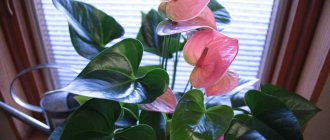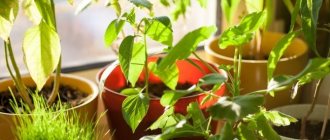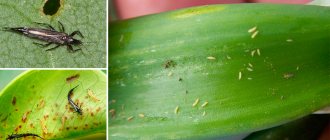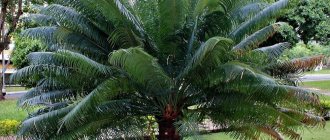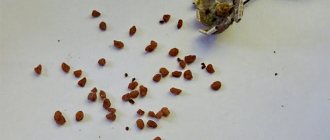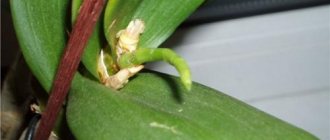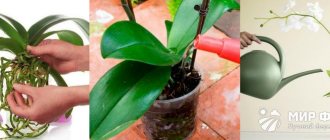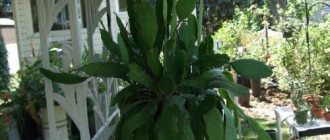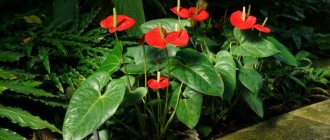When a gardener wants to acquire an amazingly beautiful flower, anthurium will clearly be among the candidates. It grows in South America and Central America. It belongs to the Araceae family. It takes root well and blooms when kept indoors. The plant is popular among gardeners due to its amazingly beautiful appearance and uniquely shaped flowers.
There is an opinion that anthurium brings its owner good luck and money, and helps in the fight against life's troubles. The special shape of the flowers gave birth to a legend about its ability to increase male potency. It is for this reason that it began to be called “Men’s Happiness”. How to grow anthurium at home? We will talk about this in more detail in the article.
The flower is usually chosen by people who are accustomed to enjoying the little things in life and appreciating the beauty that surrounds them. It can decorate even a boring interior design, adding a unique element of originality to it. It is not difficult to choose a suitable variety of anthurium, because there are several hundred species. This allows you to purchase a copy that matches the color and appearance of the design. Each variety of flower has a unique smell. There are plants with a delicate, pleasant aroma, and there are species whose smell is pungent and fetid.
The flower has become a real find for artists. They use it when painting still lifes. Photographers use the plant as part of the background for photographic sessions. It is also believed that anthurium converts negative energy in the home into positive energy. There is an opinion among flower growers that it has a beneficial effect on the course of the owner’s affairs and contributes to their positive resolution.
Characteristics and description of the flower
Anthurium is a tropical plant that can be found in nature in South or Central America. Information about the flower first appeared at the beginning of the 19th century, but the plant did not gain popularity due to the fact that it required maximum attention and compliance with the rules of care.
Anthurium was grown only in special greenhouses, where temperature, humidity and lighting standards were observed. Later, with the advent of new, more adapted hybrid varieties, the popularity of the flower began to increase. Now it is impossible to imagine an amateur gardener who would not be familiar with anthurium.
The evergreen perennial plant belongs to the Araceae family. Refers to herbaceous or shrubby representatives of the flora. It has aerial roots, the tips of which are on the surface of the soil.
The height of anthurium ranges from 50 to 80 cm. In the collection of the family you can find about 800 species of anthurium, so the appearance of individual varieties may differ.
| Leaves | You can find plants with round or pointed leaf tips. In this case, their shape can be heart-shaped, arrow-shaped, lanceolate or spade-shaped. They can be either whole or dissected. The density also varies from thin to fleshy. The surface of the leaf can be smooth and in rare cases velvety. |
| Flowers | The flower is actually shaped like a spadix and has an inconspicuous hue. At the same time, the perianth leaf, which many people mistake for a flower, stands out as a bright spot against the background of the greenery of the plant. The leaf has a dense and smooth texture and comes in a variety of vibrant colors and shapes. |
Conditions under which anthurium does not bloom
Anthurium is demanding of care and knows how to send distress signals. The first question is always, anthurium does not bloom, what should I do? If an adult plant does not gain color, it means that its contents are impaired. Therefore, for a bush that has no signs of disease, flowering can be stimulated:
- temporarily reduce the temperature below 20 0;
- replant the plant;
- Before the onset of spring activity, water the Anthurium flower once with water at a temperature of 40-50 0.
These are special measures, but at the same time you should create normal lighting and be sure of proper care.
If we draw an analogy with the human body, then flowering is associated with reproductive function. It will come in a mature body, in which there is enough strength to bear a healthy fetus. In a stressful situation, a miscarriage may occur.
Also, the plant only decides to procreate when the nutrition and maintenance allow it not only to throw away the flower, but to obtain seeds. So, a flower will not appear if the plant does not have enough nutrition, heat, or light. If the conditions of detention are violated, when the peduncle is released, a “miscarriage” occurs - the flowers dry on the anthurium. The reason has long been determined by nature. In critical circumstances, it is necessary to preserve the mother; she will later give birth to offspring in better conditions.
If the roots cannot feed the entire plant, then priority is selected. But there may not be enough food for the leaves, and then they die too. But such a state of the plant on the verge of survival requires rescue. Even an atrium that has lived in an apartment for a long time, constantly blooming, can begin to act up. In any case, there are reasons for this.
What does anthurium look like in the interior?
A bright plant, some species of which can bloom all year round, will add rich colors to your interior. The variety of varieties, colors and shapes makes it easy to choose a plant for any room.
Please note that the aroma of the flower may also vary between varieties. You can find a plant with either a pleasant and light or a foul and pungent odor.
It is also believed that the presence of anthurium in an apartment has a positive effect on the general condition of its residents. The flower takes away all the negativity and gives out positive energy. For plant owners, things will always be in order, and all sorts of undertakings will be crowned with success.
Why do anthurium leaves turn yellow?
In a healthy plant, the surface of the leaves looks smooth, shiny or matte. In some species it is velvety. Moreover, it is made decorative not only by inflorescences of greenish, white or bright colors (pink, red, purple), but also by leaf plates - solid, deeply dissected. The types with cut edges are especially good.
At home, most often, you can find such popular decorative foliage varieties of anthurium as:
- crystal;
- Andre (white, red);
- Schurzer, Hooker, Veitch.
If you notice a spot (yellow, brown or black) on the surface of dark green leaves, then there is a reason that spoils their appearance. Perhaps this is a sign of plant disease.
Why does anthurium turn yellow at home?
Anthurium, as a truly tropical crop, prefers a warm, humid microclimate and diffused light. The flower immediately reacts to any deviation from comfortable conditions.
First of all, the leaves of the anthurium begin to turn yellow. And it is quite natural that a gardener, especially an inexperienced one, wonders why and for what reason such undesirable changes occur.
The most common reason is non-compliance with plant care rules. However, quite often anthurium can turn yellow after being purchased in a store, once at home. Because the air in the apartment is drier and the temperature is completely different, the flower will need some time to adapt to the lighting.
If the anthurium leaves continue to turn yellow, solving the problem will take longer and will require knowledge of specific measures to help.
Reasons why anthurium leaves turn yellow:
- direct sunlight hitting the surface of the leaves causes a burn, from which the foliage begins to turn yellow and then dries out. A similar result is noted in insufficient lighting of the place where the pot with anthurium is located;
- the conditions of growing a flower in a too tight or very loose pot, as well as a lack of substrate, are fraught with yellowing of the leaves;
- negative impact of low temperatures. In winter, when anthurium is left near an open window, or in spring, if a plant placed on a balcony is forgotten to be brought into the apartment when it gets colder, it results in yellowing of the leaves.
excessive watering, stagnation of water in the pan, spoils the root system of the flower, which leads to the appearance of yellowness on its leaves. The same effect will be achieved by using hard water (including when spraying);
In addition to these reasons, the leaf turns yellow due to attached pests - aphids, mealybugs. They suck the juices out of the plant and it turns yellow.
And also, perhaps, the flower is affected by fusarium. In this case, total yellowing of the leaves and their wilting are observed.
A deficiency of iron and magnesium in the soil is the cause of an infectious disease called chlorosis. In this case, yellowness on the leaf plate is inevitable.
If there is not enough nitrogen in the substrate, this will cause yellowing of the lower leaves of the anthurium. The appearance of the plant will suffer in the same way from a lack or excess of sulfur and manganese in the soil.
Why do anthurium leaves turn yellow after transplantation?
It happens that after transplantation, the leaves of a flower begin to turn yellow. Obviously, this was facilitated by the actions of the grower, due to which the plant became worse:
- During transplantation, the root system of the anthurium was damaged;
- the soil has been chosen incorrectly or the crop is adapting to new conditions;
- After transplantation, the flower was over-watered.
Other mistakes also occur, which are usually made due to ignorance of the nuances of anthurium transplantation.
First of all, this concerns the complete replacement of the soil. For example, if you leave part of the “store-bought soil” in the pot and then add your own, then after replanting it will be difficult for the plant to adapt to two substrates that are completely different in air and water permeability, nutritional properties, and substrates.
Tip: to transplant a healthy flower, use the transshipment method.
The capacity of the flower pot must correspond to the volume of the root system. When replanting later, it is increased by one size (a space the size of a finger remains between the old lump of soil and the edge of the pot).
Why do the tips of anthurium leaves dry out?
During the hot summer months or winter, when heating is on in residential areas, the tips of the leaves of the flower may dry out. The reason is dry air. A culture that thrives ideally in greenhouse conditions requires high humidity (85-95%) for the health of its leaf blades.
Perhaps the appearance of dry leaf tips was due to insufficient oxygen reaching the anthurium roots. Or the drying of the leaf along the edges provoked a disease - anthractic disease.
Types of anthurium
As already mentioned, the anthurium family has more than 800 species. The most popular have become several varieties that are distinguished by their lush and variegated flowering.
| Variety | Brief characteristics |
| Anthurium Andre | One of the most popular types. It is distinguished by a bright periflower blanket of red, less often white tones. It has a glossy surface with faint wrinkles. The appearance of the leaves is shaped like a heart, about 30 cm long and 12 cm wide. The leaf is attached to a long petiole. The inflorescence itself has the shape of a light-colored cob. Among the variety of indoor plants there is also the Anthurium Andre Champion variety, which is distinguished by more voluminous flowering. |
| Anthurium Scherzer | One of the most famous indoor species. It has a yellow or orange cob color surrounded by a red-orange spathe. The bright sheet has a not too dense structure with a varnished surface. The leaves are oval or lanceolate in shape with a sharp apex. Painted dark green. The surface below is matte, the surface above is glossy. They are located on petioles from 5 to 20 cm long. |
| Anthurium crystal | It is distinguished by the original color of the leaves, against a dark green background of which silver-white veins stand out. The leaves with a pointed apex are large, approximately 40 cm long. The small perianth leaf is almost invisible, as it is also colored green. The inflorescence has the shape of a yellow spadix. |
| Baker's Anthurium | A plant with narrow green oval-lanceolate leaves, reaching a length of about 50 cm. The flowers are very small and are located below the foliage level. The bedspread is painted yellow-green with purple edging. |
| Anthurium mix | A hybrid plant variety bred from the popular species Anthurium Andre and Anthurium Scherzer. It has a more compact size and abundant flowering. Such hybrids are more adapted to home growing conditions. |
When do the buds of “male happiness” begin to appear and how long does the process last?
Anthurium is completely devoted to flowering, only in conditions close to a tropical climate. This is a capricious plant. When does the “male happiness” flower begin to bloom and how long does the plant bloom? If the owner has taken into account all the nuances of the content, then flowering lasts from the beginning of spring until autumn, but many species have only winter flowering.
Important! Anthurium flowering lasts up to 4 weeks, provided there is warmth, sunlight and air humidification. The plant does not like to be moved frequently. In winter, the soil should not dry out. Shadow and drafts will negatively affect its development.
Anthurium bloom is like nothing else. During the female phase, only the stigmas are visible, and the stamens are hidden in the perianth. Drops of sweet liquid are visible on the stigmas, to which insects react. As the liquid dries, stamens appear. As they develop, they cover the stigma with their length. After pollination, the stamens retract and the anthurium again takes on the appearance of the female phase. The duration of flowering ranges from several hours to several weeks. Depends on the variety.
Rules for growing at home
To keep your flower pleasing to the eye for a long time, regularly follow simple care rules.
Where can I place
Anthurium does not tolerate drafts, but requires an abundance of natural light. If your windows don't have cracks, place the plant on the windowsill. Otherwise, choose a place in a room with sufficient sunlight and no drafts. It is not recommended to leave anthurium near sources of artificial heat and electrical appliances, the influence of which negatively affects its health.
In winter, move the flower to the bathroom if there is a window there. High humidity and good lighting will help maintain the condition of the plant. In summer, you can place the anthurium in the living room or bedroom.
According to the teachings of Feng Shui, in order for a flower to absorb negativity and release positive energy, the pot must be installed in the eastern wing of the room.
Lighting
Anthurium loves plenty of natural light. However, it should be soft and diffused. Under no circumstances should leaves or flowers be exposed to direct sunlight. In summer you can place the pot in partial shade, and in winter you can place it near a window on the south side.
Which pot is suitable for the flower?
To create the optimal temperature for growing, choose a pot made of plastic. When choosing the size of the container, be guided by the following:
- the plant has aerial roots, which grow more to the sides rather than deep, so you will need a pot that is not deep and wide;
- if you want to propagate a flower, choose a wider container;
- for abundant flowering you will need a tight pot;
- in a vessel that is too large, diseases and harmful microorganisms can develop;
- A pot with a diameter of about 30 cm is suitable for an adult plant.
Priming
The soil should be as close to natural as possible, therefore it is necessary that the substrate has good air capacity, is well loosened and allows moisture to pass through. You can buy ready-made soil in the store or prepare it yourself. The main condition is a slightly acidic soil environment with a pH level from 5.0 to 6.0.
There are several options for preparing a suitable substrate. To obtain soil, simply mix these ingredients.
| Option 1. | Mix:
|
| Option 2. | Take all components in equal volume:
|
| Option 3. | Component ratio:
|
A suitable soil mixture should ideally consist of large granules that will not be compacted when watering, and will also be able to hold the plant well in the pot and ensure the necessary gas exchange.
Feeding and fertilizers
Anthurium does not have enough regular watering. In order for the plant to maintain lush foliage and not get sick, it needs to be fed.
You need to start fertilizing in early spring. Both mineral and organic fertilizers with a high nitrogen content are suitable for the procedure. With the arrival of summer, change your medications to phosphorus-containing ones. Since the roots of the plant are very vulnerable, when preparing the fertilizer, add 2 times more water than indicated in the instructions for the preparation.
Fertilize once every two weeks, pouring fertilizer under the roots and pouring water on top for better absorption of nutrients.
Temperature
Anthurium is thermophilic and can easily withstand high temperatures. In summer, the optimal temperature will be from 20 to 25 degrees, in winter - from 16 to 18 degrees. It is not recommended to install the plant near heating devices, as their influence will dry out the soil and the flower will lose the necessary moisture.
Air humidity
Anthurium loves high humidity, as well as warmth. The air humidity in the room should be approximately 80%. To achieve a suitable humidity level for growing a flower:
- install a humidifier near the plant;
- Place a container with wet pebbles or expanded clay under the pot;
- You can put a little moss on the ground so that its surface does not dry out;
- From time to time, spray the leaves with water from a spray bottle, bypassing the inflorescences;
- Do not overwater the soil, as this may rot the roots.
Your task is to create tropical conditions native to anthurium with high temperature and humidity.
Watering rules
For watering, use only settled or filtered water. Anthurium loves abundant but moderate watering. It’s easy to check the plant’s readiness for moisture - insert a wooden stick into the substrate; if lumps of earth do not stick to its surface, then watering is required. The optimal time for moistening is the moment when the soil has dried out to about 1/3 in depth.
In spring and summer, the regularity of watering should be no more than once every 3 days, and in autumn and winter it should be reduced to 1-2 times a week.
Trimming
Perform pruning immediately after the plant has flowered. Cut the wilted bud at the base with a sharp knife, and sprinkle the cut with activated carbon powder. If the perianth cover is already quite dry, carefully tear it off. The core will dry out over time and be easily removed.
How to feed and prune a plant
Creating comfortable living conditions and proper watering will not bring the desired result if anthurium fertilizer is not used during flowering. It is this that allows you to achieve lush leaves and good flowering. Fertilizer for anthurium also helps reduce the risk of diseases in the plant and helps it fight pests more effectively.
To do this, in the summer from March to autumn, mixtures based on mineral and organic elements are added to the soil. Fertilizer for anthurium at home is produced once every two weeks. In this case, the mixtures (solutions) used are alternated. Feeding anthurium at home is sold in special stores for gardeners. They can help you choose the best fertilizers.
The buds are pruned after they have bloomed. In this case, they need to be trimmed carefully with a sharp knife at the base. The cut is sprinkled with activated carbon. The inflorescence cover can be cut off after it has dried. The core usually separates from the plant after drying on its own.
Transfer
Throughout its life, the plant requires regular replanting. Your actions must be careful and careful not to injure the delicate roots of the anthurium.
When to replant anthurium
First of all, replant the anthurium immediately after purchase, since store-bought substrate may contain excessive amounts of minerals and carcinogens.
Subsequent transplants will be required as the root system grows. For young plants, the frequency of transplants is 1 time per year. It is advisable to replant flowers that have reached four years of age at least once every 3 years.
Also, replanting or replacing the soil will be required if the anthurium gets sick.
Choosing a pot
Choose a pot depending on the base of the transplant. For example:
- if the root system has occupied the entire substrate, choose a container 2–3 cm larger than the previous one;
- if new shoots are needed, choose a wider vessel;
- for abundant flowering when replanting, take a form that is larger in size than the old one by a maximum of 2 cm;
- For planting young shoots, use small 200 ml cups.
There must be holes at the bottom of the pot for drainage.
Before use, be sure to disinfect the container with soapy water or pour boiling water over it.
Land for replanting
For replanting, use a soil type suitable for anthurium. You can buy a ready-made mixture or prepare the substrate yourself.
Anthurium transplant after purchase
Perform the procedure approximately 4–5 days after purchase. This time will be enough to acclimatize the plant.
Action plan:
- Water the soil thoroughly.
- If the pot is plastic, knead it a little so that the substrate moves away from the walls.
- Carefully remove the root ball from the container.
- If possible, remove any old soil from the root hairs.
- Carefully inspect the roots for damage and rotting.
- Fill the new form with a drainage layer, such as expanded clay.
- Fill the drainage with new soil.
- Place the plant in the pot and cover it with soil, leaving 2-3 cm to the edge of the container.
- Lightly compact the substrate.
When replanting to replace soil, the roots are completely cleared of soil. To make the soil move away from the hairs more easily, briefly soak the root ball in water.
Is it possible to replant a flowering plant?
Despite the fact that most plants do not survive transplantation during flowering, anthurium survives the procedure quite well. During replanting, pay utmost attention to both the integrity of the root hairs and the flowers.
Transplanting a diseased anthurium
If the leaves of the anthurium turn yellow, become deformed or wither, then the functioning of the root system has been disrupted. To revive the plant, you will have to replant the flower and replace the soil.
The procedure is no different from a regular transplant. However, during the procedure, pay special attention to clearing the rhizome from soil and processing the hairs. Carefully examine the roots and remove diseased and rotten parts. Treat the remaining hairs with Actellik. Also separate yellow and wilted leaves from the bush.
What to do after transplant
To ensure that anthurium takes root in a new substrate, follow the following recommendations:
- in the first 15–20 days, water less often than usual so that the roots do not rot from excess moisture;
- during the same period, do not add any fertilizers to the soil;
- provide the plant with optimal temperature conditions ranging from 20 to 22 degrees;
- do not place the flower in places exposed to direct sunlight;
- Spray the surface of the sheets with settled water daily.
If the plant is large, strengthen the stems by tying them to a support.
What does this plant mean?
Anthurium means “flower” and “tail”. Obviously, the plant received this name due to its appearance. There is a beautiful legend about the origin of the anthurium flower .
The leader of one of the ancient Indian tribes saw a beautiful young girl from a neighboring tribe and wanted to marry her. The bride was in despair - she was already in love, and the chosen one reciprocated her feelings. By refusing the man, she brought disaster on her fellow tribesmen: the rejected groom was offended and went to war against his neighbors, deciding to forcefully take the beauty as his wife.
They decided to celebrate the victory and the wedding day on the same day: according to established tradition, they lit a festive bonfire. The desperate bride could not bear her new fate and decided to commit suicide by jumping into the fire.
The flames of the fire consumed her, dressed in a bright red wedding robe, and even the Indian gods, who were watching this action, were imbued with the girl’s act and decided to immortalize her brave soul, breathing it into a beautiful bright red flower called anthurium.
According to Feng Shui
The peculiarity of anthurium, according to the ancient Eastern philosophy of Feng Shui, is its ability to relieve a person of depression, bring harmony to his thoughts, and set him in a positive mood. In addition, the flower helps to clarify consciousness and increase intuition.
He knows how to attract money into a house, but only if decent people with bright thoughts live in it. Anthurium reacts very subtly to the emotional atmosphere in the house and is a kind of catalyst for negativity: bad energy is destructive for it.
For men
It is believed that anthurium has a masculine aura and energetically nourishes its owner, giving him activity and determination.
The plant symbolizes freedom and bestows its owner with such valuable qualities as courage and courage. Anthurium is a symbol of male potency and stamina . If a man has problems in the sexual sphere, the energy of the plant contributes to the return of former power and masculine strength.
For women
People often call the flower “men’s happiness.” It is believed that an unmarried woman should have a pot of this plant in her home to attract male energy into it. If buds appear on a flower in a short time, this means that a man will soon appear in the life of its owner.
Reference ! Anthurium has its own “other half” - a related plant, spathiphyllum, which is popularly called “women’s happiness”. For a single woman, the appearance of this plant in the house promises a change in marital status, and for a married woman - early motherhood.
Anthurium is often paired with spathiphyllum, which has delicate white flowers. Both plants together, planted in one pot, symbolize a strong and harmonious family union in which idyll and mutual understanding reign.
Anthurium propagation methods
To propagate the plant, wait until the anthurium reaches maturity. There are several methods of reproduction, each of which has certain subtleties and nuances.
Daughter plants
The method is quite simple and guarantees almost 100% results. It is better to carry out the procedure at the time of transplanting the anthurium.
Pre-prepare small containers with soil for planting sprouts. Immediately after removing the adult plant from the pot, carefully separate the young shoots along with the roots and plant them in molds. Young anthuriums should be cared for in the same way as adults. If the root system of the shoots is not sufficiently developed, it can be grown in a mixture of overwater and sand.
Apical cuttings
Reproduction in this way is possible only during the period when the plant is not blooming. Procedure:
- Prepare the substrate by mixing peat and sand in equal proportions.
- Cut the apical stalk 5 to 8 cm long.
- Ventilate the cutting for no more than 5 minutes, and then root it in the substrate.
- Cover containers with sprouts with polyethylene, creating a greenhouse effect.
- Moisten the sand-peat mixture daily and ventilate the sprouts.
Some gardeners dip the cuttings into settled water, where they are also able to take root.
Seed propagation
The peculiarity of planting anthurium seeds is the quality of the material. Only fresh seeds can sprout. If you have the opportunity to buy fresh seeds or collect seeds from your plant, you can safely use this propagation method.
If you want to collect seeds from your plant, be prepared for the process to take a very long time.
First of all, in order for fruits with seeds to appear, the flowering plant must be pollinated. Transfer pollen from the stamens to the pistils of the flower with a soft brush and repeat the procedure after a few days to ensure uniform maturation of the buds.
If you do everything correctly, in 6–8 months you will see fruits on the plant. The seeds are considered ripe after the fruits have changed color. Remove them from the fruit and dry them for several days.
After drying, the seeds can be planted. For this:
- Prepare a small, wide container and loose soil, such as peat.
- Carefully transfer the seeds into the soil and sprinkle with a thin layer (no more than 3 mm) of substrate.
- Moisten the surface of the soil with seeds using a spray bottle.
- Place the containers in a bright place, away from direct sunlight, covering them with polyethylene. The air temperature should be kept between 20 and 24 degrees.
- Spray the soil and ventilate the crops daily.
You will notice the first buds after 7–14 days, and a leaf after about 4–5 weeks. When 3 leaves appear on the shoot, the seedlings should be planted in separate forms.
Why did anthurium stop blooming?
It happens that anthurium blooms magnificently, and then stops flowering and new foliage does not appear.
First of all, the plant needs to be replanted. A flower bought in a store especially needs this. Indoor flowers arrive on store shelves in shipping containers with a small amount of peat, fertilizers and chemicals. The supply of these funds is designed for a month - two flowerings. But at this time there is no development of roots and foliage. If the plant is not replanted in time, it will become exhausted and die.
After this, the anthurium needs some period to strengthen the roots and ground parts. Often this period extends for several months. Sometimes pets that were pleasing to the eye with lush inflorescences stop blooming. In these cases, the method used in industrial greenhouses or conservatories is often used. For this purpose, from late autumn the plant is placed in a well-lit room where the temperature is maintained from 16° C to 20° C. If necessary, artificial lighting can be added.
“Women's happiness” is watered regularly, but not as abundantly as in the summer. Then, after a couple of months, when new stems and leaves appear on the ground part of the bush, it needs to be moved to a warmer room and watering increased. The most comfortable temperature will be around 23° C.
If the plant has not yet bloomed, it will definitely send out peduncles. Anthurium blooms in the spring and this period lasts a long time: about one and a half to two months, if you remember to follow the rules of flower care.
Diseases and possible pests
Anthurium is rarely affected by disease. All problems with his health often appear due to improper care. It is enough to restore the temperature and light conditions, adjust the humidity and watering for the plant to be revived.
Pests that settle on a flower can cause a lot of trouble.
| Pest | Signs of appearance | Treatment |
| Aphid | The leaves dry out and the plant grows slowly. They settle mainly on the underside of the leaf blade. | Treat the stems and leaves of anthurium with a special insecticide against the parasite. |
| Shields | Beige or brown tubercles appear on the leaves. Easily separated from the surface with a wooden stick. | Water the plant with a solution of a systemic insecticide, for example, Aktara. The substance will be absorbed into the sap of the plant and enter the body of the parasite, thereby neutralizing it. |
| Spider mite | On the surface of the plant you may notice cobwebs or punctures in the leaf blade. | First of all, wash the leaves of the flower with a soapy solution, and then treat with an acaricide. |
| Thrips (small midges) | Microorganisms that can cause a fungus or virus are left on the surface of the leaf plate. As a result, the leaves become pale yellow or white. | Treat the bush with special products. Additionally, sticky traps can be installed. |
| Whiteflies | Butterflies are very easy to spot. They affect the leaf plate, as a result of which the leaves become deformed and lose color. | Treat the plant with special insecticides. |
Where to put it in the house?
In its natural habitat, anthurium grows in the shade of the crowns of dense tropical trees; it does not tolerate direct sunlight, preferring soft, diffused light.
When choosing the location of a flower pot, you should consider which side the windows in the house face. Plants located on the windowsill on the east or west side will receive a lot of light. Bright light is allowed, but it must be diffused . If it is not possible to ensure this condition, it would be more favorable for the flower to be placed in the back of the room.
If there is insufficient lighting for lush flowering, you can additionally illuminate the area where the plant is located with a special lamp. But it is best to place the anthurium on a window located on the north side.
Solving problems and difficulties during cultivation
While growing anthurium, you may encounter some problems and difficulties, the timely solution of which will help cure and restore the plant.
Why do the leaves dry out and turn yellow?
Yellowness and dryness of the leaves indicate that the plant is either in a draft or simply frozen. By restoring the temperature regime and moving the pot to another place, you will bring the flower back to life.
Why do anthurium leaves crack?
If the leaves are cracked, then the soil or the quality of the water used for irrigation is not suitable for the plant. The flower should not be watered with fresh running water. Before watering, the liquid must stand in the room for at least a day.
Why doesn't anthurium bloom?
Lack of flowering can be caused by insufficient lighting, disturbed temperature conditions and lack of fertilizing. Simply fertilize the soil and move the pot to a suitable room with more light. Also, anthurium may not bloom if its root system is significantly smaller in volume than the substrate. In such a case, simply transplant the plant into a smaller pot.
What to do if there are brown spots on the leaves
There may be several reasons for this phenomenon:
- excessive watering;
- incorrectly selected soil;
- the plant is too hot and dry (the tips of the leaves darken);
- anthracnose fungus (there is a small black dot in the center of the spot).
Once proper care is restored, the stains will go away. If the flower is infected with fungus, spray the leaves with an antifungal agent, following the instructions on the package.
If the leaves have darkened completely, it means that you are watering the anthurium with too cold and unsettled water.
How to update an old anthurium
As the anthurium grows, old leaves die off and new ones form on top. Due to this phenomenon, the flower loses its presentable appearance. To restore the plant's attractiveness, cut off and root the top. The procedure is convenient to do during transplantation.
Why do Anthurium flowers turn green?
For some varieties this is a natural process that occurs at the end of flowering. If you carefully remove the green flowers, it will be easier for the plant and it will bloom again faster. If the process is regular, the rules of care may have been violated, and if restored, the problem will go away.
If the roots have rotted, how to save the anthurium
If the roots are completely rotten, try to restore the plant by rooting cuttings. Perform all actions in the same way as during reproduction.
Why does anthurium grow poorly?
If the anthurium begins to grow slowly, think about whether you have changed its location, due to which the quality of lighting or watering has changed. Mineral fertilizers and fertilizing, as well as the resumption of proper watering and lighting levels, will help restore the flower.
Why does anthurium have small leaves and flowers?
With a similar phenomenon, anthurium indicates a lack of nutrients, moisture or lighting. Feed the plant, restore watering and lighting, and the flower will grow.
Why does anthurium wither?
It happens that the flower begins to emit an unpleasant odor. The problem can be caused by either hypothermia of the plant or fsarium disease, which appears from an excess of liquid, as well as infection from pets or dirty hands.
How often does anthurium bloom?
Anthurium blooms for more than six months, resting only in the harsh winter. The first flowers bloom as early as March and can remain on the stems for several months. When cut, anthurium flowers can last in water for about a month.
Growing an anthurium is not difficult if you follow all the subtleties of care: install the flower in a suitable place, regularly feed and replant, and observe watering standards. The plant reacts instantly to any violation of the regime. Before purchasing an anthurium, consider whether you can provide the flower with proper care.
Flowering period
Anthurium blooms almost all year round. During the cold winter months, of course, it is dormant. Proper care ensures that buds begin to form even in early spring. The flowering period lasts several months. Cut flowers can last up to a month in a bloomed state.
It is worth noting once again that the plant is finicky. It is quite difficult to get it to bloom. But if you create favorable conditions for it and properly care for it, it will bloom with the most beautiful buds.
Why doesn't anthurium bloom at home? The problem may be in the soil, which is depleted in minerals and organic matter. In order to enrich it, special feeding is required in the form of additives and vitamins.
Flowering can be prevented by poor watering. Therefore, you should make sure that the water for it is filtered and settled. It was also at room temperature. There should be no impurities in the water. You should not water the anthurium with stagnant water.
You can increase the chances of flowering by covering the soil with a layer of sphagnum moss. This will prevent the soil from drying out on hot days. Do not expose the plant to direct light. If it is in the sun, it should be shaded. To do this, it is placed in partial shade or tulle is used as a barrier to light.
In winter, the plant needs intense lighting as well as in summer. In case of insufficient light, artificial sources must be used to increase daylight hours.
The flower does not like frequent rearrangements from place to place. This should be done no more than twice a year. It is advisable to choose spring and autumn for rearrangement.
When flowering begins, the anthurium should be placed in a dark place, avoiding direct rays. When it has bloomed, the frequency of watering is increased. Spraying also needs to be done quite often. A spray bottle is suitable for this.
The flower, which is commonly called “Male Happiness,” is a plant amazing in its qualities and aesthetics. Anthurium forms beautiful buds that look picturesque. But achieving flowering is not so easy; optimal conditions and proper care are needed. It takes a lot of time, so before you buy a flower, you should think about whether you want to spend your time and energy on growing anthurium.
Anthurium - indoor flamingo flower
Areca palm chrysalidocarpus - home care
ANTHURIUM (Anthurium) is an evergreen, beautifully flowering plant, known as the “flamingo flower”. This is the most numerous genus of plants belonging to the araceae family. In the photo: Scherzer's Anthurium (Anthurium scherzerianum).
- How to properly care?
- Why do the leaves turn yellow?
- How to propagate correctly?
This Araceae family includes about 110 genera and more than 1800 species, among which there are widespread indoor flowers (spathiphyllum...). Previously, anthurium was grown for its beautiful flowers, making bouquets of them, today it is also an ornamental plant.
Anthurium is native to the tropical and subtropical rain forests of America, as well as the forests of the islands of the Caribbean archipelago. There are about 800 species of this genus in nature. Under natural conditions, these are epiphytic plants growing on trees with aerial roots descending to the base of the forest floor. Anthurium can also be a terrestrial plant; climbing along the stem of a tree, it becomes an epiphyte.
Translated from Greek, “ANTHURIUM” sounds like “flower-tail”, due to the similarity of the cob with the tail. The main advantage of home anthurium is its unusually shaped flower, looking at which you get the impression that it is not real, but made of plastic. On a long stem, a white, pale pink, purple or red leaf-shaped blanket opens, bent to the side, and above it stretches a yellow or white cob, consisting of many small flowers collected in an inflorescence. This is how the anthurium flower appears before us. The unusual glossy petal is only a bract. The bract may cover the inflorescence on one side, or may be perpendicular to it.
Varieties for the windowsill
Although a huge number of anthurium varieties are found in nature, mainly four hybrid varieties are grown on windowsills. In greenhouses - more. It’s just that not all tropical guests can adapt to the conditions of city apartments. But even those that can are very capricious.
- "Andre." A plant with a short trunk, leathery, heart-shaped leaves. This species has captivated flower growers with its fantastic shades of inflorescences, expressive bracts and year-round flowering period. Another feature of the variety: after flowering, the bedspread does not fade, but becomes coarser and acquires a green color. But there are also disadvantages: reviews say that “Andre” is capricious, so it is difficult for beginning flower growers to provide it with proper care and achieve flowering all year round.
- "Scherzer". The least capricious type of “male happiness”. The plant adapts to apartment conditions more easily than other varieties. You can recognize it by its shortened stem, on which dark green elongated leaves flaunt. A distinctive feature is the roundness of the bedspread. The oval bract can be almost any color: white, pinkish, burning red, yellow and even speckled.
- "Crystal". This variety is grown to admire the leaves, because it blooms inconspicuously. But the leaves are truly beautiful: large, heart-shaped, velvety, with bright silver veins. The color of the foliage changes: you brought home a flower with a bronze-purple blanket, and, a year later, received it with a dark green one.
- "Majestic". Like Khrustalny, it belongs to the decorative deciduous variety. The flower grows quickly, its leaves can reach impressive sizes - about 40 cm. The leaf blade is green (sometimes purple), with distinct white veins appearing on it. This variety is difficult to grow. A headache for flower growers is tick infestation. Insects like this type of “male happiness” more than other varieties.
Breeders are developing more and more new varieties of the popular indoor plant. One of the latest achievements of selection is the anthurium “Andre” with green and black bracts. Looks amazing!

